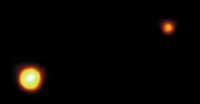The planet Pluto, until when
Two American astronomers first reported on Pluto, as in 1915 they thought and said that the ninth planet could be based on various measurements. However, until 1930 the new planet was not identified. That year, young researcher Clyde Tombaugh, assistant to the Lowell Observatory in Arizona, discovered what two other astronomers thought and announced 15 years earlier.
From the very moment it was discovered, concern arose for Pluto to decide whether a planet could be considered. However, the decision had to be decided and made. This is therefore the ninth planet that included the small planet in the list of planets in the Solar System.

The discoveries that have been made in the last two decades have given rise to initial doubts. The debate arises and Pluto may soon lose such a worthy category of planet. Currently, two groups of the International Astronomical Association, which determines the names of objects in space, are working to decide the category of Pluto.
Despite his own satellite, Pluto has a smaller diameter than the Moon. Not much is known yet about Pluto – the probe that is about to reach it is going to bring more information than there is – but it seems to have a certain atmosphere that shows some activity as it approaches the Sun. Its orbit with respect to the plane of circulation of the other planets is very exposed
and curved. It rotates around the axis in 6 days, 9 hours and 18 minutes and makes the orbit around the Sun in 248 years. Sun The planet furthest from the system is Pluto, an average of 5,913 million kilometers from the Sun.
Besides being the farthest, Pluto is the smallest planet in the Solar System, with only 2,200 kilometers in diameter. Because of its trajectory, it sometimes also enters the orbit of Neptune, which continues to function. In addition, many astronomers believe that Pluto would be the satellite of Neptune, which was left out of orbit by some planetary catastrophe. Pluto has a satellite called Charon, discovered in 1978. Because its size is similar to Pluto, many researchers have also said it is a double planet for many years. The Charon is 19,000 kilometers from the planet and in volume is half the planet. Due to its low density (0.5-0.9 g/cm3), many astronomers believe that compact methane can be the main component of the planet. In 1989 the Voyager II spacecraft found three hoops around Pluto.
On the other hand, it should be noted that recently asteroids have been found that move beyond Neptune and Pluto, rather than rocks, that look like ice structures, so Pluto is only the largest of these asteroids, the largest of those found so far. Other astronomers have gone further and -other barbar- have regarded Pluto as an asteroid. Almost 10,000 asteroids have already been found and there is a concrete proposal: Apply this number to Pluto when finding asteroid 10,000.
As you can see, it is not easy to detect what will happen to Pluto from now on, if the International Astronomical Association will make one or another decision.
The decision itself is also not easy, since it is difficult to say exactly what the planet is, how much the limit of the mass has to be to consider or not a planet. For example, the planet Earth we live on, if we compare it to Jupiter, would be just a simple asteroid, like the moon of Jupiter. However, no one denies the Earth any category of planet, no one questions it. Because of his smallness, it seems that Pluto's future may be different. Therefore, it is possible that in the future when talking about the Solar System in schools eight planets should be mentioned.
Published in 7
Buletina
Bidali zure helbide elektronikoa eta jaso asteroko buletina zure sarrera-ontzian











